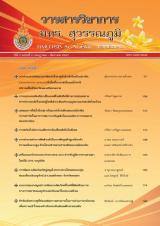การสกัดน้ำมันจากเมล็ดกระทิงเพือผลิตไบโอดีเซล
Main Article Content
Abstract
การวิจัยนี้มีจุดประสงค์เพื่อศึกษาการผลิตไบโอดีเซลจากน้ำมันที่สกัดจากเมล็ดกระทิง (Calophyllum inophyllum L.) จากการหาชนิดของตัวทำละลายที่เหมาะสมในการสกัดน้ำมัน พบว่า เฮกเซน สามารถสกัดน้ำ มันจากเมล็ดกระทิงได้มากที่สุด ร้อยละ 73.53 0.64 เมื่อทดสอบสมบัติทางกายภาพและทางเคมีของน้ำมันที่สกัดได้ พบว่า มีความชื้น ร้อยละ 3.57
0.15 ความหนืด 47.03
0.12 เซนติสโตก ค่าสะพอนิฟิเคชันเท่ากับ 211.56
0.66 ค่าไอโอดีนเท่ากับ 66.82 ฑ 2.53 กรัม I2/100 กรัม ความเป็นกรด 7.07
0.07 มิลลิกรัม KOH/กรัม และค่าเปอร์ออกไซด์ 9.86
1.34 เมื่อนำน้ำมันที่ได้ไปผลิตเป็นไบโอดีเซล โดยการทำปฏิกิริยากับเมทานอล ร้อยละ 25 โดยปริมาตร และใช้โซเดียมไฮดรอกไซด์ เข้มข้นร้อยละ 0.5 โดยมวลต่อปริมาตร เป็นตัวเร่งปฏิกิริยา ที่อุณหภูมิ 60 องศาเซลเซียส เป็นเวลา 30 นาที ได้น้ำมันไบโอดีเซลร้อยละ 74.67
1.86 ผลการทดสอบสมบัติทางกายภาพของน้ำมันไบโอดีเซลที่ได้ พบว่า มีจุดวาบไฟ 195.0
3.6 องศาเซลเซียส จุดไหลเท -0.66
0.02 องศาเซลเซียส ความหนืด 6.8
0.2 เซนติสโตก และความถ่วงจำเพาะ 0.86
0.01 กรัมต่อมิลลิลิตร เมื่อเปรียบเทียบกับค่ามาตรฐานตามข้อกำหนดของกรมธุรกิจพลังงานปี พ.ศ. 2552 แล้ว พบว่า น้ำมันไบโอดีเซลที่ได้มีสมบัติใกล้เคียงกับมาตรฐานที่กำหนด แต่เนื่องจากน้ำมันจากเมล็ดกระทิงที่ได้มีความเป็นกรดค่อนข้างสูง จึงควรใช้ตัวเร่งปฏิกิริยาที่เป็นกรดเพื่อเปลี่ยนกรดไขมันอิสระให้เป็นอัลคิลเอสเทอร์ก่อน จะทำให้ประสิทธิภาพการผลิตน้ำมันไบโอดีเซลสูงขึน
Extraction of Alexandrian Laurel (Calophyllum inophyllum L.) Seed Oil for Biodiesel Production.
This research purposed to study the biodiesel production from the Alexandrian Laurel (Calophyllum inophyllum L.) seed oil. The results from the extraction showed that hexane was the appropriated solvent which yielded at 73.53 0.64%. From the physical and chemical properties, the moisture content was 3.57
0.15%, the viscosity was 47.03
0.12 cSt, the saponification value was 211.56
0.66, the iodine value was 66.82
2.53 gI2/100 g, the acidity was 7.07
0.07 mg KOH/g and the peroxide was 9.86
1.34. To produce biodiesel, extracted oil had reacted with the methanol (25% v/v of oil) at 60 oC in 30 minutes and NaOH (0.5% w/v of oil) was used as the catalyst. The yield of biodiesel under the optimized conditions was 74.67
1.86 %. The results from the physical test of biodiesel, the flash point was 195.0
3.6 oC, the pour point was -0.65
0.02 oC, the viscosity was 6.8 + 0.2 cSt and the specific gravity was 0.86
0.01 g/mL.. Additionally, the properties of biodiesel on the Alexandrian Laurel seed oil were closed to the standard value of the Department of Energy Business standard in 2009. However, the acidity of the extracted oil was too high; thereforethe acid catalyst was used to convert free fatty acids to alkyl ester in order togain the higher yield of biodiesel.
Article Details
Published manuscript are the rights of their original owners and RMUTSB Academic Journal. The manuscript content belongs to the authors' idea, it is not the opinion of the journal's committee and not the responsibility of Rajamangala University of Technology Suvarnabhumi


